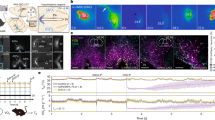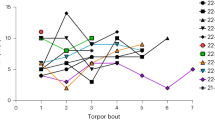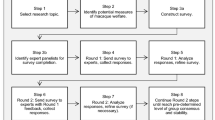Abstract
Ethical research practices are a key component of scientific integrity and of public support for research. Hibernation research presents specific ethical issues in regard to animal welfare. In this article, the authors apply the '3Rs' principles of humane experimental technique (replacement, reduction and refinement) to hibernation research. They provide recommendations for hibernation researchers and suggest future directions for addressing issues specific to hibernation research. They discuss the use of appropriate behavioral and physiological monitoring procedures, the development of species-specific brain atlases for placement of brain probes, the provision of environmental enrichment and the management of studies involving pharmacological induction of torpor. Addressing these issues in hibernation research will lead to improvements in research outcomes and in welfare of hibernating species.
This is a preview of subscription content, access via your institution
Access options
Subscribe to this journal
We are sorry, but there is no personal subscription option available for your country.
Buy this article
- Purchase on Springer Link
- Instant access to full article PDF
Prices may be subject to local taxes which are calculated during checkout


Similar content being viewed by others
References
Drew, K.L. et al. Central nervous system regulation of mammalian hibernation: implications for metabolic suppression and ischemia tolerance. J. Neurochem. 102, 1713–1726 (2007).
Carey, H.V., Andrews, M.T. & Martin, S.L. Mammalian hibernation: cellular and molecular responses to depressed metabolism and low temperature. Physiol. Rev. 83, 1153–1181 (2003).
Geiser, F. Metabolic rate and body temperature reduction during hibernation and daily torpor. Annu. Rev. Physiol. 66, 239–274 (2004).
Barnes, B.M. Freeze avoidance in a mammal: body temperatures below 0 degree C in an Arctic hibernator. Science 244, 1593–1595 (1989).
Heldmaier, G., Ortmann, S. & Elvert, R. Natural hypometabolism during hibernation and daily torpor in mammals. Respir. Physiol. Neurobiol. 141, 317–329 (2004).
Jinka, T.R., Tøien, Ø. & Drew, K.L. Season primes the brain in an arctic hibernator to facilitate entrance into torpor mediated by adenosine A1 receptors. J. Neurosci. 31, 10752–10758 (2011).
Dave, K.R. et al. Neuroprotection: lessons from hibernators. Comp. Biochem. Physiol. B Biochem. Mol. Biol. 162, 1–9 (2012).
Drew, K.L. et al. Hibernation: a natural model of tolerance to cerebral ischemia/reperfusion in Innate Tolerance in the CNS (eds. Gidday, J., Perez-Pinzon, M.A. & Zhang, J.) 37–50 (Springer, New York, 2013).
Drew, K.L. et al. “Natural” tolerance in hibernators: Can we learn from physiological and preconditioning against ischemic or hypoxic brain injury?. in Ischemic Tolerance of the Brain (ed. Schaller, B.J.) 1–44 (Research Signpost, Trivandrum, Kerala, India, 2009).
Drew, K.L. & Jinka, T.R. The bioenergetic network of adenosine. in Hibernation, Sleep, and Thermoregulation (eds. Masino, S. & Boison, D.) 253–272 (Springer, New York, 2013).
Rosania, K. Inducing hibernation in the arctic ground squirrel. Lab Anim. (NY) 40, 262 (2011).
Macrina, F.L. Scientific Integrity: Text and Cases in Responsible Conduct of Research 3rd edn. (ASM Press, Washington, DC, 2005).
Institute of Laboratory Animal Resources. Guide for the Care and Use of Laboratory Animals (National Academies Press, Washington, DC, 1996).
Silverman, J. et al. The IACUC Handbook 2nd edn. (CRC Press, Boca Raton, FL, 2007).
Russell, W.M.S. & Burch, R.L. The Principles of Humane Experimental Technique (Methuen, London, 1959).
Fabre, I. [Alternatives to animal testing.] Bull. Acad. Natl. Med. 193, 1783–1791 (2009).
Claude, N. [Reducing the use of laboratory animals.] Bull. Acad. Natl. Med. 193, 1767–1772 (2009).
Gibson, W.C. The cost of not doing medical research. J. Am. Med. Assoc. 244, 1817–1819 (1980).
Shanks, N. Animals and Science: A Guide to the Debates (ABC-CLIO, Santa Barbara, CA, 2002).
Frey, R.G. Justifying animal experimentation. Society 39, 37–47 (2002).
Singer, P. Animal Liberation (Avon Books, New York, 1990).
Hewitt, R.E. Biobanking: the foundation of personalized medicine. Curr. Opin. Oncol. 23, 112–119 (2011).
Salkind, N.J. (ed.) Encyclopedia of Research Design (SAGE Publications, Thousand Oaks, CA, 2010).
Pengelley, E.T. & Fisher, K.C. Rhythmical arousal from hibernation in the golden-mantled ground squirrel, Citellus lateralis tescorum. Can. J. Zool. 39, 105–120 (1961).
Jinka, T.R., Rasley, B.T. & Drew, K.L. Inhibition of NMDA-type glutamate receptors induces arousal from torpor in hibernating arctic ground squirrels (Urocitellus parryii). J. Neurochem. 122, 934–940 (2012).
Karpovich, S.A. et al. Energetics of arousal episodes in hibernating arctic ground squirrels. J. Comp. Physiol. B 179, 691–700 (2009).
Tøien, Ø. et al. Hibernation in black bears: independence of metabolic suppression from body temperature. Science 331, 906–909 (2011).
Jinka, T.R. et al. Potential mechanisms of metabolic suppression downstream of central a1ar activation during onset of torpor in Living in a Seasonal World: Thermoregulatory and Metabolic Adaptations (eds. Ruf, T. et al.) 363–376 (Springer, Heidelberg, 2012).
Jinka, T.R. et al. Altered thermoregulation via sensitization of A1 adenosine receptors in dietary-restricted rats. Psychopharmacol. (Berl.) 209, 217–224 (2010).
Wacker, C.B., Rojas, D.A. & Geiser, F. The use of small subcutaneous transponders for quantifying thermal biology and torpor in small mammals. J. Thermal Biol. 37, 250–254 (2012).
Williams, C.T. et al. Data logging of body temperatures provides precise information on phenology of reproductive events in a free-living Arctic hibernator. J. Comp. Physiol. B 181, 1101–1109 (2011).
Pellegrino, L.J., Pellegrino, A.S. & Cushman, A.J. A Stereotaxic Atlas of the Rat Brain 2nd edn. (Plenum, New York, 1979).
Paxinos, G. & Watson, C. The Rat Brain: In Stereotaxic Coordinates 2nd edn. (Academic, New York, 1986).
Shirley, J.R. et al. A Stereotaxic Atlas of the Brain of the 13-line Ground Squirrel (Citellus tridecemlineatus) (Edgewood Arsenal Medical Research Laboratory, Edgewood, MD, 1966).
Aggarwal, M. et al. Magnetic resonance imaging and micro-computed tomography combined atlas of developing and adult mouse brains for stereotaxic surgery. Neuroscience 162, 1339–1350 (2009).
Hik, D., McColl Jr., S.C. & Boonstra, R. Why are Arctic ground squirrels more stressed in the boreal forest than in alpine meadows? Ecoscience 8, 275–288 (2001).
Carl, E.A. Population control in arctic ground squirrels. Ecology 52, 395–413 (1971).
Buck, C.L. & Barnes, B. Temperatures of hibernacula and changes in body composition of arctic ground squirrels over winter. J. Mammal. 80, 1264–1276 (1999).
Merriman, D.K. et al. Current practices in a captive breeding colony of 13-lined ground squirrels (Ictidomys tridecemlineatus). Lab Anim. (NY) 41, 315–325 (2012).
Wasser, S.K. et al. A generalized fecal glucocorticoid assay for use in a diverse array of nondomestic mammalian and avian species. Gen. Comp. Endocrinol. 120, 260–275 (2000).
Vaughan, D.K. et al. Capture, care, and captive breeding of 13-lined ground squirrels, Spermophilus tridecemlineatus. Lab Anim. (NY) 35, 33–40 (2006).
Keay, J.M. et al. Fecal glucocorticoids and their metabolites as indicators of stress in various mammalian species: A literature review. J. Zoo Wildlife Med. 37, 234–244 (2006).
Jurke, M.H. et al. Monitoring hormones in urine and feces of captive bonobos (Pan paniscus). Primates 41, 311–319 (2000).
Peel, A.J. et al. Non-invasive fecal hormone analysis and behavioral observations for monitoring stress responses in captive western lowland gorillas (Gorilla gorilla gorilla). Zoo Biol. 24, 431–445 (2005).
Carlstead, K., Brown, J.L. & Seidensticker, J. Behavioral and adrenocortical responses to environmental changes in leopard cats (Felis bengalensis). Zoo Biol. 12, 321–331 (1993).
Geiser, F. & Ferguson, C. Intraspecific differences in behaviour and physiology: effects of captive breeding on patterns of torpor in feathertail gliders. J. Comp. Physiol. B 171, 569–576 (2001).
Fenn, A.M., Zervanos, S.M. & Florant, G.L. Energetic relationships between field and laboratory woodchucks (Marmota monax) along a latitudinal gradient. Ethol. Ecol. Evol. 21, 299–315 (2009).
Zervanos, S.M. et al. Latitudinal differences in the hibernation characteristics of woodchucks (Marmota monax). Physiol. Biochem. Zool. 83, 135–141 (2010).
Stawski, C. Comparision of variables of torpor between populations of a hibernating subtropical/tropical bat at different latitudes in Living in a Seasonal World: Thermoregulatory and Metabolic Adaptations (eds. Ruf, T. et al.) 99–108 (Springer, Heidelberg, 2012).
Shintani, M. et al. Characterization of N(6)-cyclohexyladenosine-induced hypothermia in Syrian hamsters. J. Pharmacol. Sci. 97, 451–454 (2005).
Kilduff, T.S. et al. Sleep and mammalian hibernation: homologous adaptations and homologous processes? Sleep 16, 372–386 (1993).
Jinka, T.R. Natural protection against cardiac arrhythmias during hibernation: significance of adenosine. in Cardiac Arrhythmias - New Considerations (ed. Breijo-Marquez, F.R.) 151–166 (InTech, Rijeka, Croatia, 2012).
Geiser, F. Hibernation, daily torpor and estivation in mammals and birds: behavioral aspects. in Encyclopedia of Animal Behavior (eds. Breed, M.D. & Moore, J.) 77–83 (Academic, Oxford, 2012).
Swoap, S.J. & Weinshenker, D. Norepinephrine controls both torpor initiation and emergence via distinct mechanisms in the mouse. PLoS One 3, e4038 (2008).
Geiser, F. & Ruf, T. Hibernation versus daily torpor in mammals and birds: physiological variables and classification of torpor patterns. Physiol. Zool. 68, 935–966 (1995).
Buck, C.L. & Barnes, B.M. Effects of ambient temperature on metabolic rate, respiratory quotient, and torpor in an arctic hibernator. Am. J. Physiol. Regul. Integr. Comp. Physiol. 279, R255–R262 (2000).
Geiser, F. Hibernation: Endotherms. In eLS (John Wiley & Sons, Ltd, Chichester, UK, 2011).
Acknowledgements
We thank Dr. Kelly L. Drew for her review and comments and the following agencies for funding: US Army Research Office (Grant W911NF-05-1-0280); US Army Medical Research and Material Command (Grant 05178001); National Institute of Neurological Disorders and Stroke (Grants NS041069-06 and R15NS070779); and Alaska Experimental Program to Stimulate Competitive Research.
Author information
Authors and Affiliations
Corresponding author
Ethics declarations
Competing interests
The authors declare no competing financial interests.
Rights and permissions
About this article
Cite this article
Jinka, T., Duffy, L. Ethical considerations in hibernation research. Lab Anim 42, 248–252 (2013). https://doi.org/10.1038/laban.253
Received:
Accepted:
Published:
Issue Date:
DOI: https://doi.org/10.1038/laban.253



